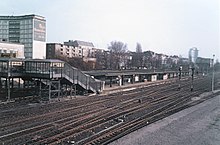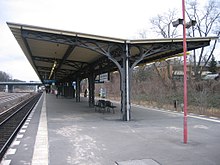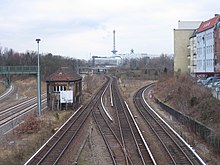Berlin-Halensee train station
| Berlin-Halensee | |
|---|---|
|
Halensee S-Bahn station, 2011
|
|
| Data | |
| Location in the network | Separation station |
| Design | Through station |
| Platform tracks | 2 (S-Bahn) |
| abbreviation | BHAL (S-Bahn) BHLR, BHLRS (long-distance train) |
| IBNR | 8089109 |
| Price range | 4th |
| opening | November 15, 1877 December 17, 1993 |
| Conveyance | September 18, 1980 |
| Website URL | sbahn.berlin |
| Profile on Bahnhof.de | Berlin-Halensee |
| location | |
| City / municipality | Berlin |
| Place / district | Halensee |
| country | Berlin |
| Country | Germany |
| Coordinates | 52 ° 29 '46 " N , 13 ° 17' 26" E |
| Railway lines | |
|
|
| Railway stations in Berlin | |
The Berlin-Halensee station is an S-Bahn station in the Berlin district of the same name, Halensee, in the Charlottenburg-Wilmersdorf district . It is located on the Ringbahn and is connected to the tram crossing to the north via a link . The station is located on Kurfürstendamm , which ends around 300 meters to the west at Rathenauplatz, and became famous when the signal box was occupied during the Berlin S-Bahn strike in 1980.
The S-Bahn station has a parking and turning system , which is located east of the platform.
history
Early years
The station was opened on November 15, 1877 together with the extension of the ring line from Schöneberg to Moabit . The initially simply set up stop was located south of today's platform on the site of the sweeping system and was named Grunewald . In 1884 the facility was rebuilt, with the old platform being removed in favor of a four-track sweeping system. To the north of this, two platforms were built for the circular railroad trains and the trains that run from here to and from the Stadtbahn via a newly established connecting curve. At the same time, the name was changed to Halensee , while the nearby Hundekehle station on the Wetzlarer Bahn was given the name Grunewald . A representative reception building on Kurfürstendamm completed the facility.
The reception building was a two-story brick building in the neo-Romanesque style . It was located at the northwest end of the train station with exits to Kurfürstendamm and the adjacent Seesener Straße . The glazed entrances to the two platforms A and B , known colloquially as “ greenhouses ”, are attached to the building. The roof construction of the two platforms consisted of a central, single-stem roof construction, as you could only find on the Ringbahn. Supports of this type can still be found at Prenzlauer Allee station , among other places. The four-track sweeping system was connected to the south, while the city and ring railways were separated to the north of the station.
On November 6, 1928, electrical operations began. To this end, all suburban traffic systems were converted, the signals were converted, the platforms were raised to the height of 960 millimeters that is still valid today, and further measures were taken. As train groups, train group A ran along the entire Ringbahn and the Südringpitzkehre, as well as train group G, which swung from Mahlsdorf via the east and city railways onto the ring and then ran via the Neukölln – Baumschulenweg connection to the Görlitzer Bahn in the direction of Grünau . On Sundays, the group E was driven in excursion traffic, which drove as a full ring.
According to Hitler's drafts for a “ World Capital Germania ” in the 1930s , the Ringbahn was to be fundamentally expanded. The Halensee station was to receive a further single-track platform west of the existing platforms. The background was the creation of a connecting curve from the ring to the city railway, which, in contrast to the existing one, led to the west where a new Westbahnhof was to be located instead of the old Westkreuz station . The measures never got beyond the planning stage.
During the Second World War , the station building was hit by Allied bombers and then burned down. The ruins remained in place for another 15 years and continued to serve as access to the train station. The city was now separated, but the management of the S-Bahn continued to be the responsibility of the Deutsche Reichsbahn .
At the instigation of the Berlin Senate , which had the Halenseebrücke rebuilt and in 1958 the previous reception building was demolished, a new pavilion-style building was erected in the same place in 1960. The client was the administration of the former Reichsbahn property .
S-Bahn boycott and Reichsbahn strike

After the Berlin Wall on 13 August 1961, it was four days later - the German Trade Union Federation and the Governing Mayor Willy Brandt proclaimed - boycott of the S-Bahn . "The S-Bahn driver pays for the border fortifications on the inner-Berlin border," it said. The action met with widespread approval at an early stage and around 400,000 passengers turned away from the S-Bahn, although the GDR citizens' traffic crossing West Berlin , which has now been canceled, was also a cause. In spite of this, the Reichsbahn initially retained the old cycle densities, on train group A even until 1980. However, starting in May 1976, the terminals at Sonnenallee and Köllnische Heide alternated . Train group G (Friedrichstraße - Köllnische Heide) coming from the Stadtbahn was discontinued at the same time.
From May 1977 until the strike in 1980, train group C ran between Zoo and Sonnenallee (previously from Gesundbrunnen ) in rush hour.
Because of the drastic drop in passenger numbers, the Reichsbahn was increasingly forced to thin out operations. However, just thinning out the timetable was not enough to compensate for the annual deficit of 120 to 140 million marks . This also resulted in savings in personnel. The remaining West Berlin Reichsbahner complained about the extra work they had to pay as well as about the lower pay compared to other West companies. When the DR announced a further cost-cutting measure in September 1980, the first work stoppages occurred on September 15. The strike climaxed two days later, when all traffic in the west was cut off. Reichsbahner occupied the signal box in Hal in the station. The subsequent train drivers are also said to have removed the main fuses from the trains so that any strikebreakers could not continue the traffic.
The West Berlin police, however, were not able to clear the signal box, as the systems were owned by the DR and therefore did not belong to the territory of West Berlin. This only happened on September 22nd through the transport police , which consisted of West Berlin state railroaders, and British soldiers . The eight strikers were subsequently arrested.
Three days later, the strike had largely subsided, so that the next steps could be determined. The Ringbahn was then shut down and operations only continued on the Stadtbahn and in the north-south tunnel and the adjacent lines.
Interim use and reopening
After the temporary shutdown, the station area increasingly fell into disrepair. The reception building and the glazed walkway continued to be used as a showroom for a car dealership from 1985, but the former was demolished in 1993. In the following years numerous discussions sparked about the reopening of the line. Among the various proposals on how to restore the railway systems, there was also the variant of "capping" the S-Bahn line including the parallel city motorway , i.e. converting the entire line into a tunnel. The area above should provide space for 1,400 to 1,600 apartments. However, the lack of private investors ensured that the project was put on hold.
In 1989 the decision was made to restart the Ringbahn until 1991. Initially, only the Westend - Schöneberg section was to go into operation. However, due to the reunification of the two halves of the city, it was decided to reopen the route to Baumschulenweg .
The station was then extensively repaired. Since the Südringkurve with one track was only to be used for operational trips, one platform was sufficient; the old platform A was then removed. With the remaining one, the covering and the superstructures were renewed and the roof structure was also replaced. The greenhouse corridors were kept in their modern form. The station also received an elevator. The sweeping system in the south, on the other hand, was reduced to just one track, as the new route runs over the remaining area. Shortly before it was put back into operation, the old station building was also demolished due to its disrepair. The area lies fallow to this day. The inauguration of the section took place on December 17, 1993.
Since the end of 2015, train handling has been carried out by the driver using the driver's cab monitor (ZAT-FM).
Although there is still space for a second platform and the station was initially only temporarily modernized, no expansion is currently planned. The capping of the ring line section in the Halensee area is also currently not a topical issue. In addition to the lack of investors, Deutsche Bahn also pursued other plans for the site at times.
Freight depot

The Halensee freight station was located on the freight train tracks of the Ringbahn, southwest of the S-Bahn platform . The former eight-track freight yard was in operation until the 1990s. Part of the site was still used by businesses afterwards. After the area was cleared from summer 2010, a hardware store was built in 2013 on a 40,000 m² section .
On June 2, 1913, the cemetery railway from Wannsee to Stahnsdorf was opened. A corpse unloading hall was built at the station there, in which the coffins from Berlin were reloaded from freight cars onto carts. The Prussian State Railroad set up the associated loading point for the coffins on the freight area of Halensee station.
At the former freight station, a connecting curve branches off the long-distance railway tracks of the Ringbahn, which leads via the Grunewald storage facility to the Wetzlarer Bahn .
Connection
The S-Bahn station is served by lines S41, S42 and S46 of the S-Bahn Berlin. There is a possibility to change to the bus lines of the Berliner Verkehrsbetriebe .
| line | course | Clock in the peak hours |
|---|---|---|
|
|
Gesundbrunnen - Schönhauser Allee - Prenzlauer Allee - Greifswalder Strasse - Landsberger Allee - Storkower Strasse - Frankfurter Allee - Ostkreuz - Treptower Park - Sonnenallee - Neukölln - Hermannstrasse - Tempelhof - Südkreuz - Schöneberg - Innsbrucker Platz - Bundesplatz - Heidelberger Platz - Hohenzollerndamm - Halensee - Westkreuz - Messe Nord / ICC - Westend - Jungfernheide - Beusselstraße - Westhafen - Wedding - Gesundbrunnen | 5 min |
|
|
Westend - Messe Nord / ICC - Westkreuz - Halensee - Hohenzollerndamm - Heidelberger Platz - Bundesplatz - Innsbrucker Platz - Schöneberg - Südkreuz - Tempelhof - Hermannstraße - Neukölln - Köllnische Heide - Baumschulenweg - Schöneweide - Schöneweide depot - Adlershof - Grünau - Eichwalde - Zeuthen - Wildau - Königs Wusterhausen | 20 min |
literature
- Berlin S-Bahn Museum (ed.): Endless route. The Berlin Ringbahn . Verlag GVE, Berlin 2002, ISBN 3-89218-074-1 .
Web links
- Halensee train station on stadtschnellbahn-berlin.de
Individual evidence
- ↑ Station price list 2020. In: Deutsche Bahn. Deutsche Bahn, January 1, 2020, accessed on July 10, 2020 .
- ↑ a b Halensee S-Bahn station. In: berlin.de. May 26, 2006, accessed June 21, 2018 .
- ↑ Study for a transport association in West Berlin, TU Berlin, 1981
- ↑ News in brief - S-Bahn . In: Berliner Verkehrsblätter . No. 1 , 2016, p. 13 .
- ↑ News in brief - Railway . In: Berliner Verkehrsblätter . No. 7 , 2013, p. 136 .
- ^ Hansjörg F. Zureck: 100 years of the cemetery railway . In: Berliner Verkehrsblätter . No. 6 , 2013, p. 101 .






